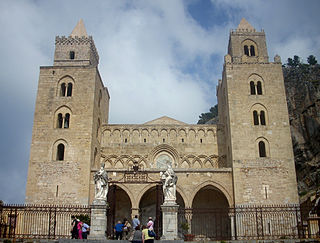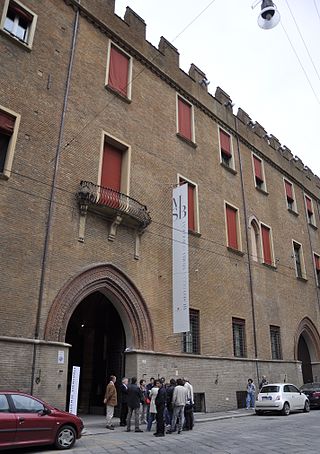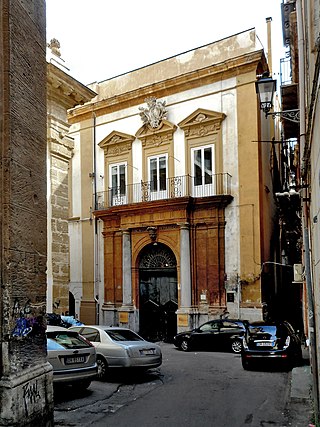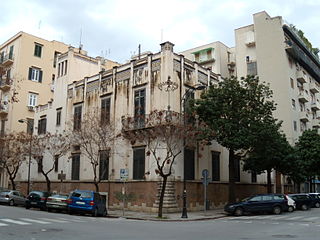
Joachim Murat was a French military commander and statesman who served during the French Revolutionary Wars and Napoleonic Wars. Under the French Empire he received the military titles of Marshal of the Empire and Admiral of France. He was the first Prince Murat, Grand Duke of Berg from 1806 to 1808, and King of Naples as Joachim-Napoleon from 1808 to 1815.

Carolina Maria Annunziata Bonaparte Murat Macdonald, better known as Caroline Bonaparte, was an Imperial French princess; the seventh child and third daughter of Carlo Buonaparte and Letizia Ramolino, and a younger sister of Napoleon I of France. She was queen of Naples during the reign of her spouse there, and regent of Naples during his absence four times: in 1812–1813, 1813, 1814, and 1815.

Sambuca di Sicilia is a comune (municipality) in the Province of Agrigento in the Italian region Sicily, located about 68 kilometres (42 mi) southwest of Palermo and about 89 kilometres (55 mi) northwest of Agrigento. It is a member of the I Borghi più belli d'Italia association.

The Diocese of Cefalù is a Latin diocese of the Catholic Church in Sicily, southern Italy. It is a suffragan of the Archdiocese of Palermo.

The Certosa di Bologna is a former Carthusian monastery in Bologna, northern Italy, which was founded in 1334 and suppressed in 1797. In 1801 it became the city's Monumental Cemetery which would be much praised by Byron and others. In 1869 an Etruscan necropolis, which had been in use from the sixth to the third centuries BC, was discovered here.
Castiglione may refer to:

The Palazzo Pepoli Vecchio is a Medieval palace located on Via Castiglione number 8, in central Bologna, region of Emilia-Romagna, Italy. The merlonated brick Gothic-style building is now the civic Museum of the History of Bologna. It stands across the street from the Baroque-style Palazzo Pepoli Campogrande, now a civic art gallery.

The Palazzo Pepoli Campogrande, also known as Palazzo Pepoli Nuovo, is a Baroque style palace on Via Castiglione 7 in central Bologna, region of Emilia-Romagna, Italy. In 2015, it served as a public art gallery for late-Baroque art. Across the Via, rises the medieval Palazzo Pepoli Vecchio, also once pertaining to the same family, which now serves as a museum of the history of Bologna.
The following is a timeline of the history of the city of Bologna, Emilia-Romagna region, Italy.

Palazzo Natoli is a Baroque palace in Palermo, in the Mediterranean island of Sicily. It was built by Vincenzo Natoli in 1765. It has a fine entrance on via S. Salvatore, and frescoes by Gioacchino Martorana.
The following is a timeline of the history of the city of Messina, Sicily, Italy.

The Adragna family is an Italian noble house. The family ruled the territory of Altavilla in Sicily, Italy.

Sebastiano Tusa was an Italian archaeologist and politician who served as councilor for Cultural Heritage for the Sicilian Region of Italy from 11 April 2018 until his death on 10 March 2019. Tusa also served as a professor of paleontology at the Suor Orsola Benincasa University of Naples.

The Museo regionale Agostino Pepoli is an art, archaeology and local history museum in Trapani. It is one of the most important museums in Sicily.
The Diocesan Museum of Palermo is a museum of religious art in Palermo on Sicily, housed in a number of rooms in the Palazzo Arcivescovile opposite Palermo Cathedral.

Villino Ida Basile is a former private residence designed in an art nouveau (Liberty) style by Ernesto Basile, and located on Via Siracusa #15 in the city of Palermo, Sicily, Italy.
The Presentation of the Virgin Altarpiece is a c. 1515-1517 oil on panel altarpiece by Palma Vecchio, now in the church of Santa Maria Annunziata in Serina, Lombardy, the painter's birthplace.

Penitent Magdalene is a c. 1550 oil on canvas painting by Titian, now in the Museo di Capodimonte in Naples.
















